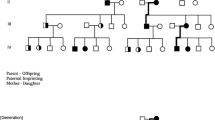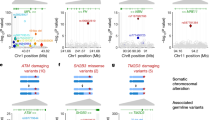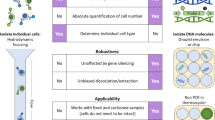Abstract
A CHIMAERA can be defined as an organism whose cells derive from two or more zygotes1. In man, two categories of spontaneous and permanent chimaeras are recognised: blood chimaeras which arise from the exchange of blood-forming cells between dizygotic twins, and dispermic chimaeras which are the result of the fusion of two zygotes and of their growth into one body (for review see ref. 2). Blood chimaeras are usually identified because of blood-grouping problems caused by the mixture of different erythrocyte populations, while dispermic chimaeras who often present sex abnormalities are mainly detected by cytogenetic studies, although they also carry a mixture of different blood cell populations. In contrast to these typical cases, we now report a unique human chimaera who shows no mixture of blood cells as far as the genetic markers investigated are concerned, and who is only detectable by the investigation of the blood of her progeny (family Eiw., Fig. 1).
This is a preview of subscription content, access via your institution
Access options
Subscribe to this journal
Receive 51 print issues and online access
$199.00 per year
only $3.90 per issue
Buy this article
- Purchase on Springer Link
- Instant access to full article PDF
Prices may be subject to local taxes which are calculated during checkout
Similar content being viewed by others
References
Anderson, D., Billingham, R. E., Lampkin, G. H. & Medawar, P. B. Heredity 5, 379–397 (1951).
Race, R. R. & Sanger, R. Blood Groups in Man, 6th edn, 511-546 (Blackwell, Oxford, 1975).
Kühnl, P., Schmidtmann, U. & Spielmann, W. Hum. Genet. 35, 219–223 (1977).
Ruddle, F. etal. Science 176, 1429–1431 (1972).
Renwick, J. H. Nature 234, 475 (1971).
Ferguson-Smith, M. A., Newman, B. F., Ellis, P. M., Thompson, D. M. G. & Riley, I. D. Nature new Biol. 243, 271–274 (1973).
Jongsma, A., Someren, H. v., Westerveld, A., Hagemeiger, A. & Pearson, P. Hum. Genet. 20, 195–202 (1973).
Allen, F. H. Jr. Vox Sang. 27, 382–384 (1974).
Westerveld, A., Jongsma, A. P. M., Meera Khan, P., Someren, H. v. & Bootsma, D. Proc. natn. Acad. Sci. U.S.A. 73, 895–899 (1976).
Shokeir, M. H. K., Ying, K. L. & Pabello, P. Clin. Genet. 4, 360–368 (1973).
Marshall, W. H., Rigo, S. J. & Melman, S. Lancet i, 730–732 (1966).
Cochrum, K. C., Main, R. K. & Kountz, S. L. Surgery 70, 97–102 (1971).
Hirschberg, H., Evensen, S. A., Henriksen, T. & Thorsby, E. Tissue Antigens 4, 257–261 (1974).
Author information
Authors and Affiliations
Rights and permissions
About this article
Cite this article
MAYR, W., PAUSCH, V. & SCHNEDL, W. Human chimaera detectable only by investigation of her progeny. Nature 277, 210–211 (1979). https://doi.org/10.1038/277210a0
Received:
Accepted:
Issue Date:
DOI: https://doi.org/10.1038/277210a0
This article is cited by
-
Somatic deficiency causes reproductive parasitism in a fungus
Nature Communications (2021)
-
A case of 46,XX/46,XX chimerism in a phenotypically normal woman
International Journal of Legal Medicine (2020)
-
Mother–child exclusion due to paternal uniparental disomy 6
International Journal of Legal Medicine (2006)
Comments
By submitting a comment you agree to abide by our Terms and Community Guidelines. If you find something abusive or that does not comply with our terms or guidelines please flag it as inappropriate.



